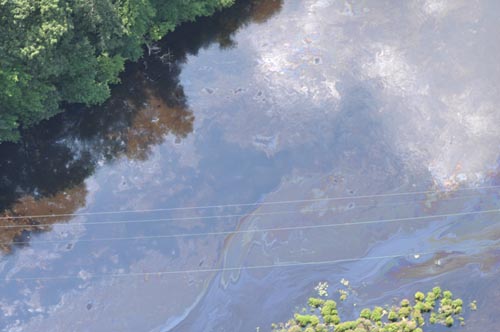Amid the media frenzy following the 800,000-gallon oil spill in the Kalamazoo River, some confusion is brewing over how much oil that is.
Specifically, just how deep it would bury a football field.

Photo: Michigan State Police
Reporter Tim Martin tried to contextualize the big spill this way Wednesday in an Associated Press article:
“An 800,000 gallon spill would be enough to fill 1-gallon jugs lined side by side for nearly 70 miles. It also could fill a wall-in football field including the end zones with a 14-foot-high pool of oil.”
News outlets from Indiana to Los Angeles ran the AP article, and gossip blog Gawker plucked out that quote in particular.
The day before the AP story, the Detroit Free Press took it to the gridiron:
“The spilled oil — enough to cover a football field to a depth of more than 2 feet — had been bound for refineries in Detroit, Toledo and Sarnia, Ontario.”
First off, any amount of oil that can be measured in football fields is more than ought to be flowing down the Kalamazoo. But that’s a seven-fold disparity between the AP and the Free Press. How does that happen?
Like so many of life’s great problems, this looks like one of unit conversion.
A football field is 360 feet long by 160 feet wide, or 57600 square feet. Multiply that by the AP’s depth of 14 feet, and you get 806,400 cubic feet.
That 800,000 ballpark figure looks familiar, but the pipeline didn’t leak 800,000 cubic feet of oil. It leaked 800,000 gallons of oil (maybe more depending on who you ask).
If you multiply 360 feet by 160 feet by the Free Press’s depth of 2 feet, you get 115,200 cubic feet. A quick Google search says that’s around 860,000 gallons, which is in the range of estimates the size of the spill.
So the Free Press wins this time. The AP — and the Kalamazoo River’s people and wildlife — lose.